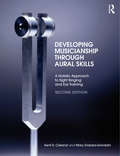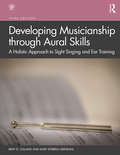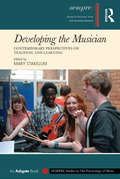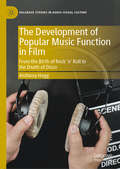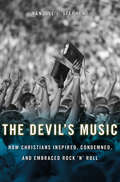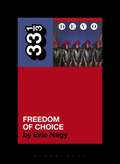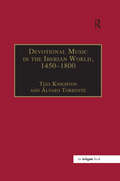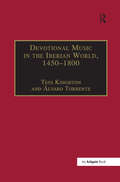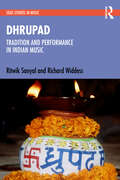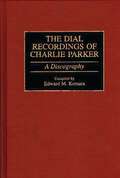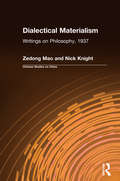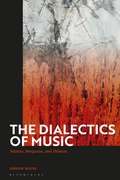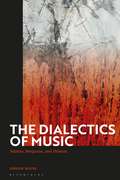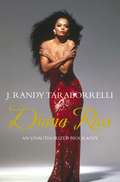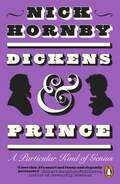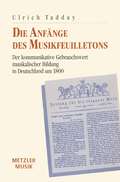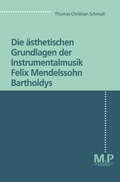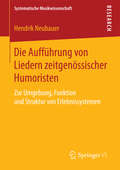- Table View
- List View
Developing Musicianship Through Aural Skills: A Holistic Approach to Sight Singing and Ear Training
by Kent D. Cleland Mary Dobrea-GrindahlDeveloping Musicianship through Aural Skills, Second Edition, is a comprehensive method for learning to hear, sing, understand, and use the foundations of music as part of an integrated curriculum, incorporating both sight singing and ear training in one volume. Under the umbrella of musicianship, this textbook guides students to "hear what they see, and see what they hear," with a trained, discerning ear on both a musical and an aesthetic level. Key features of this new edition include: Revised organization, with exercises gradually progressing from the simple to more difficult, taking beginner students’ varied skill sets into account. An enhanced companion website, with interactive training modules for students to practice core skills, and additional exercises, dictation lesson plans and worksheets for instructors Enhanced coverage and a specific methodology for covering post-tonal material Greater emphasis on developing improvisation skills and realizing lead sheets The text reinforces both musicianship and theory in a systematic method, and its holistic approach provides students the skills necessary to incorporate professionalism, creativity, confidence, and performance preparation in their music education. The second edition of Developing Musicianship through Aural Skills provides a strong foundation for undergraduate music students and answers the need for combining skills in a more holistic, integrated music theory core.
Developing Musicianship Through Aural Skills: A Holistic Approach to Sight Singing and Ear Training
by Kent D. Cleland Mary Dobrea-GrindahlDeveloping Musicianship through Aural Skills, Second Edition, is a comprehensive method for learning to hear, sing, understand, and use the foundations of music as part of an integrated curriculum, incorporating both sight singing and ear training in one volume. Under the umbrella of musicianship, this textbook guides students to "hear what they see, and see what they hear," with a trained, discerning ear on both a musical and an aesthetic level. Key features of this new edition include: Revised organization, with exercises gradually progressing from the simple to more difficult, taking beginner students’ varied skill sets into account. An enhanced companion website, with interactive training modules for students to practice core skills, and additional exercises, dictation lesson plans and worksheets for instructors Enhanced coverage and a specific methodology for covering post-tonal material Greater emphasis on developing improvisation skills and realizing lead sheets The text reinforces both musicianship and theory in a systematic method, and its holistic approach provides students the skills necessary to incorporate professionalism, creativity, confidence, and performance preparation in their music education. The second edition of Developing Musicianship through Aural Skills provides a strong foundation for undergraduate music students and answers the need for combining skills in a more holistic, integrated music theory core.
Developing Musicianship through Aural Skills: A Holistic Approach to Sight Singing and Ear Training
by Kent D. Cleland Mary Dobrea-GrindahlDeveloping Musicianship through Aural Skills, Third Edition, is a comprehensive method for learning to hear, sing, understand, and use the foundations of music as part of an integrated curriculum, incorporating both sight singing and ear training in one volume. Under the umbrella of musicianship, this textbook guides students to "hear what they see, and see what they hear," with a trained, discerning ear on both a musical and an aesthetic level. Key features of this new edition include: Revised selection of musical examples, with added new examples including more excerpts from the literature, more part music, and examples at a wider range of levels, from easy to challenging New instructional material on dictation, phrase structure, hearing cadences, and reading lead sheets and Nashville number charts An updated website that now includes a comprehensive Teacher’s Guide with sample lesson plans, supplemental assignments, and test banks; instructional videos; and enhanced dictation exercises The text reinforces both musicianship and theory in a systematic method, and its holistic approach provides students the skills necessary to incorporate professionalism, creativity, confidence, and performance preparation in their music education. Over 1,600 musical examples represent a wide range of musical styles and genres, including classical, jazz, musical theatre, popular, and folk music. The third edition of Developing Musicianship through Aural Skills provides a strong foundation for undergraduate music students and answers the need for combining skills in a more holistic, integrated music theory core.
Developing Musicianship through Aural Skills: A Holistic Approach to Sight Singing and Ear Training
by Kent D. Cleland Mary Dobrea-GrindahlDeveloping Musicianship through Aural Skills, Third Edition, is a comprehensive method for learning to hear, sing, understand, and use the foundations of music as part of an integrated curriculum, incorporating both sight singing and ear training in one volume. Under the umbrella of musicianship, this textbook guides students to "hear what they see, and see what they hear," with a trained, discerning ear on both a musical and an aesthetic level. Key features of this new edition include: Revised selection of musical examples, with added new examples including more excerpts from the literature, more part music, and examples at a wider range of levels, from easy to challenging New instructional material on dictation, phrase structure, hearing cadences, and reading lead sheets and Nashville number charts An updated website that now includes a comprehensive Teacher’s Guide with sample lesson plans, supplemental assignments, and test banks; instructional videos; and enhanced dictation exercises The text reinforces both musicianship and theory in a systematic method, and its holistic approach provides students the skills necessary to incorporate professionalism, creativity, confidence, and performance preparation in their music education. Over 1,600 musical examples represent a wide range of musical styles and genres, including classical, jazz, musical theatre, popular, and folk music. The third edition of Developing Musicianship through Aural Skills provides a strong foundation for undergraduate music students and answers the need for combining skills in a more holistic, integrated music theory core.
Developing the Musician: Contemporary Perspectives on Teaching and Learning (SEMPRE Studies in The Psychology of Music)
by Mary StakelumTo what extent does research on musical development impact on educational practices in school and the community? Do musicians from classical and popular traditions develop their identities in different ways? What do teachers and learners take into consideration when assessing progress? This book takes a fresh look at 'the musician' and what constitutes 'development' within the fields of music psychology and music education. In doing so, it explores the relationship between formative experiences and the development of the musician in a range of music education settings. It includes the perspectives of classroom teachers, popular musicians, classical musicians and music educators in higher education. Drawn from an international community of experienced educators and researchers, the contributors offer a range of approaches to research. From life history through classroom observation to content analysis, each section offers competing and complementary perspectives on contemporary practice. The book is an essential resource for musicians, educators, researchers and policy makers, offering insight into the reality of practice from those working within established traditions - such as the conservatoire and school settings - and from those who are currently emerging as significant forces in the fields of popular music education and community music.
Developing the Musician: Contemporary Perspectives on Teaching and Learning (SEMPRE Studies in The Psychology of Music)
by Mary StakelumTo what extent does research on musical development impact on educational practices in school and the community? Do musicians from classical and popular traditions develop their identities in different ways? What do teachers and learners take into consideration when assessing progress? This book takes a fresh look at 'the musician' and what constitutes 'development' within the fields of music psychology and music education. In doing so, it explores the relationship between formative experiences and the development of the musician in a range of music education settings. It includes the perspectives of classroom teachers, popular musicians, classical musicians and music educators in higher education. Drawn from an international community of experienced educators and researchers, the contributors offer a range of approaches to research. From life history through classroom observation to content analysis, each section offers competing and complementary perspectives on contemporary practice. The book is an essential resource for musicians, educators, researchers and policy makers, offering insight into the reality of practice from those working within established traditions - such as the conservatoire and school settings - and from those who are currently emerging as significant forces in the fields of popular music education and community music.
The Development of Popular Music Function in Film: From the Birth of Rock ‘n’ Roll to the Death of Disco (Palgrave Studies in Audio-Visual Culture)
by Anthony HoggThis book offers a unique examination of the development of popular music function in film. It assesses the contribution of popular music to the interpretation of the most significant films, covering the period from rock ‘n’ roll’s initial introduction at the opening of Blackboard Jungle, to the backlash against disco, which followed soon after the release of Saturday Night Fever. By dividing this period into five phases—The Classical American Musical Phase, The British Invasion Phase, The New Hollywood Alienation Phase, The Disco Phase and The Post-Disco Conservative Phase—the book pinpoints key moments at which individual developments occurred and lays out a path of expansion in popular music function. Each chapter offers close analyses of this period’s most innovative films; examines the cultural, historical, technical and industrial factors peculiar to each phase and considers the influence of these upon the specific timing of functional advances.
The Devil’s Music: How Christians Inspired, Condemned, and Embraced Rock ’n’ Roll
by Randall J. StephensWhen rock ’n’ roll emerged in the 1950s, ministers denounced it from their pulpits and Sunday school teachers warned of the music’s demonic origins. The big beat, said Billy Graham, was “ever working in the world for evil.” Yet by the early 2000s Christian rock had become a billion-dollar industry. The Devil’s Music tells the story of this transformation. Rock’s origins lie in part with the energetic Southern Pentecostal churches where Elvis, Little Richard, James Brown, and other pioneers of the genre worshipped as children. Randall J. Stephens shows that the music, styles, and ideas of tongue-speaking churches powerfully influenced these early performers. As rock ’n’ roll’s popularity grew, white preachers tried to distance their flock from this “blasphemous jungle music,” with little success. By the 1960s, Christian leaders feared the Beatles really were more popular than Jesus, as John Lennon claimed. Stephens argues that in the early days of rock ’n’ roll, faith served as a vehicle for whites’ racial fears. A decade later, evangelical Christians were at odds with the counterculture and the antiwar movement. By associating the music of blacks and hippies with godlessness, believers used their faith to justify racism and conservative politics. But in a reversal of strategy in the early 1970s, the same evangelicals embraced Christian rock as a way to express Jesus’s message within their own religious community and project it into a secular world. In Stephens’s compelling narrative, the result was a powerful fusion of conservatism and popular culture whose effects are still felt today.
The Devil’s Music: How Christians Inspired, Condemned, and Embraced Rock ’n’ Roll
by Randall J. StephensWhen rock ’n’ roll emerged in the 1950s, ministers denounced it from their pulpits and Sunday school teachers warned of the music’s demonic origins. The big beat, said Billy Graham, was “ever working in the world for evil.” Yet by the early 2000s Christian rock had become a billion-dollar industry. The Devil’s Music tells the story of this transformation. Rock’s origins lie in part with the energetic Southern Pentecostal churches where Elvis, Little Richard, James Brown, and other pioneers of the genre worshipped as children. Randall J. Stephens shows that the music, styles, and ideas of tongue-speaking churches powerfully influenced these early performers. As rock ’n’ roll’s popularity grew, white preachers tried to distance their flock from this “blasphemous jungle music,” with little success. By the 1960s, Christian leaders feared the Beatles really were more popular than Jesus, as John Lennon claimed. Stephens argues that in the early days of rock ’n’ roll, faith served as a vehicle for whites’ racial fears. A decade later, evangelical Christians were at odds with the counterculture and the antiwar movement. By associating the music of blacks and hippies with godlessness, believers used their faith to justify racism and conservative politics. But in a reversal of strategy in the early 1970s, the same evangelicals embraced Christian rock as a way to express Jesus’s message within their own religious community and project it into a secular world. In Stephens’s compelling narrative, the result was a powerful fusion of conservatism and popular culture whose effects are still felt today.
Devo's Freedom of Choice (33 1/3)
by Fred Armisen Evie NagyFinally, after all that waiting, The Future arrived in 1980. Ohio art-rockers Devo had plainly prepared with their 1979 second LP Duty Now for the Future, and now it was go time. Propelled by the new decade's high-tech, free-market, pre-AIDS promise, 1980's Freedom of Choice would rocket what Devo co-founder Gerald Casale calls his "alternate universe, hermetically sealed, alien band" both into the arms of the Earthlings and back to their home planet in one scenic trip.Before an artistic and commercial decline that resulted in a 20-year gap between Devo's last two studio records, Freedom of Choice made them curious, insurgent superstars, vindicated but ultimately betrayed by the birth of MTV. Their only platinum album represented the best of their unreplicable code: dead-serious tricksters, embracing conformity in order to destroy it with bullet-proof pop sensibility. Through first-hand accounts from the band and musical analysis set against an examination of new wave's emergence, the first-ever authorized book about Devo (with a foreword by Portlandia's Fred Armisen) explores the group's peak of success, when their hermetic seal cracked open to let in mainstream attention, a legion of new Devotees, and plenty of misunderstandings. "Freedom of Choice was the end of Devo innocence–it turned out to be the high point before the s***storm of a total cultural move to the right, the advent of AIDS, and the press starting to figure Devo out and think they had our number," says Casale. "It's where everything changes."
Devo's Freedom of Choice (33 1/3)
by Fred Armisen Evie NagyFinally, after all that waiting, The Future arrived in 1980. Ohio art-rockers Devo had plainly prepared with their 1979 second LP Duty Now for the Future, and now it was go time. Propelled by the new decade's high-tech, free-market, pre-AIDS promise, 1980's Freedom of Choice would rocket what Devo co-founder Gerald Casale calls his "alternate universe, hermetically sealed, alien band" both into the arms of the Earthlings and back to their home planet in one scenic trip.Before an artistic and commercial decline that resulted in a 20-year gap between Devo's last two studio records, Freedom of Choice made them curious, insurgent superstars, vindicated but ultimately betrayed by the birth of MTV. Their only platinum album represented the best of their unreplicable code: dead-serious tricksters, embracing conformity in order to destroy it with bullet-proof pop sensibility. Through first-hand accounts from the band and musical analysis set against an examination of new wave's emergence, the first-ever authorized book about Devo (with a foreword by Portlandia's Fred Armisen) explores the group's peak of success, when their hermetic seal cracked open to let in mainstream attention, a legion of new Devotees, and plenty of misunderstandings. "Freedom of Choice was the end of Devo innocence–it turned out to be the high point before the s***storm of a total cultural move to the right, the advent of AIDS, and the press starting to figure Devo out and think they had our number," says Casale. "It's where everything changes."
Devotional Music In The Iberian World, 1450-1800: The Villancico And Related Genres
by Álvaro Torrente Tess KnightonFrom the fifteenth century to the beginning of the nineteenth century, devotional music played a fundamental role in the Iberian world. Songs in the vernacular, usually referred to by the generic name of 'villancico', but including forms as varied as madrigals, ensaladas, tonos, cantatas or even oratorios, were regularly performed at many religious feasts in major churches, royal and private chapels, convents and in monasteries. These compositions appear to have progressively fulfilled or supplemented the role occupied by the Latin motet in other countries and, as they were often composed anew for each celebration, the surviving sources vastly outnumber those of Latin compositions; they can be counted in tens of thousands. The close relationship with secular genres, both musical, literary and performative, turned these compositions into a major vehicle for dissemination of vernacular styles throughout the Iberian world. This model of musical production was also cultivated in Portugal and rapidly exported to the Spanish and Portuguese colonies in America and Asia. In many cases, the villancico repertory represents the oldest surviving source of music produced in these regions, thus affording it a primary role in the construction of national identities. The sixteen essays in this volume explore the development of devotional music in the Iberian world in this period, providing the first broad-based survey of this important genre.
Devotional Music in the Iberian World, 1450-1800: The Villancico and Related Genres
by Tess KnightonFrom the fifteenth century to the beginning of the nineteenth century, devotional music played a fundamental role in the Iberian world. Songs in the vernacular, usually referred to by the generic name of 'villancico', but including forms as varied as madrigals, ensaladas, tonos, cantatas or even oratorios, were regularly performed at many religious feasts in major churches, royal and private chapels, convents and in monasteries. These compositions appear to have progressively fulfilled or supplemented the role occupied by the Latin motet in other countries and, as they were often composed anew for each celebration, the surviving sources vastly outnumber those of Latin compositions; they can be counted in tens of thousands. The close relationship with secular genres, both musical, literary and performative, turned these compositions into a major vehicle for dissemination of vernacular styles throughout the Iberian world. This model of musical production was also cultivated in Portugal and rapidly exported to the Spanish and Portuguese colonies in America and Asia. In many cases, the villancico repertory represents the oldest surviving source of music produced in these regions, thus affording it a primary role in the construction of national identities. The sixteen essays in this volume explore the development of devotional music in the Iberian world in this period, providing the first broad-based survey of this important genre.
Devotional Music in the Iberian World, 1450-1800: The Villancico and Related Genres
by TESS KNIGHTON AND ÁLVARO TORRENTEFrom the fifteenth century to the beginning of the nineteenth century, devotional music played a fundamental role in the Iberian world. Songs in the vernacular, usually referred to by the generic name of 'villancico', but including forms as varied as madrigals, ensaladas, tonos, cantatas or even oratorios, were regularly performed at many religious feasts in major churches, royal and private chapels, convents and in monasteries. These compositions appear to have progressively fulfilled or supplemented the role occupied by the Latin motet in other countries and, as they were often composed anew for each celebration, the surviving sources vastly outnumber those of Latin compositions; they can be counted in tens of thousands. The close relationship with secular genres, both musical, literary and performative, turned these compositions into a major vehicle for dissemination of vernacular styles throughout the Iberian world. This model of musical production was also cultivated in Portugal and rapidly exported to the Spanish and Portuguese colonies in America and Asia. In many cases, the villancico repertory represents the oldest surviving source of music produced in these regions, thus affording it a primary role in the construction of national identities. The sixteen essays in this volume explore the development of devotional music in the Iberian world in this period, providing the first broad-based survey of this important genre.
Dhrupad: Tradition and Performance in Indian Music (SOAS Studies in Music)
by Ritwik Sanyal Richard WiddessDhrupad is believed to be the oldest style of classical vocal music performed today in North India. This detailed study of the genre considers the relationship between the oral tradition, its transmission from generation to generation, and its re-creation in performance. There is an overview of the historical development of the dhrupad tradition and its performance style from the sixteenth to the nineteenth centuries, and of the musical lineages that carried it forward into the twentieth century, followed by analyses of performance techniques, processes and styles. The authors examine the relationship between the structures provided by tradition and their realization by the performer to throw light on the nature of tradition and creativity in Indian music; and the book ends with an account of the ‘revival’ movement of the late twentieth century that re-established the genre in new contexts. Augmented with an analytical transcription of a complete dhrupad performance, this is the first book-length study of an Indian vocal genre to be co-authored by an Indian practitioner and a Western musicologist.
The Dial Recordings of Charlie Parker: A Discography (Discographies: Association for Recorded Sound Collections Discographic Reference)
by Edward KomaraDial Records catered to jazz musicians and record collectors. Charlie Parker was one of the major jazz artists to record with Dial. His Dial sessions occurred at the personal depths and artistic peaks of his career during which he introduced a number of such jazz staples as Ornithology and Scrapple from the Apple. His ten sessions associated with Dial are presented in detail and include the repertory, original issues and reissues, titles and notated transcriptions, and analyses of performances. Commentary explains many of the titles to Parker's pieces and collates the various recordings in which he performed his Dial repertory outside the confines of the Dial studios; these celebrated performances helped to shape modern jazz.In addition to the catalogue of Parker's Dial recordings, jazz historians and scholars alike will appreciate the historical narrative detailing the evolution of Dial Records, its owner Ross Russell, and its business relations with Charlie Parker. This examination of the 1940's jazz record business sheds light on the dissemination of jazz via records. Five appendices complete this well organized and thorough study of Charlie Parker and his legendary Dial recordings.
Dialectical Materialism: Writings on Philosophy, 1937
by Zedong Mao Nick KnightNew and annotated translations of philosophical essays written by Mao Zedong in 1937, which have come to be regarded as a cornerstone in the development of Chinese Marxism. The editor analyzes their textual, philosophical and historical significance.
Dialectical Materialism: Writings on Philosophy, 1937
by Zedong Mao Nick KnightNew and annotated translations of philosophical essays written by Mao Zedong in 1937, which have come to be regarded as a cornerstone in the development of Chinese Marxism. The editor analyzes their textual, philosophical and historical significance.
The Dialectics of Music: Adorno, Benjamin, and Deleuze
by Joseph WeissCombining the philosophy and musicology of T.W. Adorno, Walter Benjamin, and Gilles Deleuze, alongside an exploration of the dialectical character of music production Joseph Weiss exposes the unresolved contradictions of contemporary music.By following the outermost mediations between nature, history, and technology, the book reflects on how advanced music critically responds to the ongoing catastrophe of both the Middle Passage and Auschwitz. Following what the author calls the “categorical imperative” of music, Weiss investigates the significance of a wide range of musical phenomena including the territorialization of the lullaby, the improvisation and sorrow song of the blues and jazz, as well as the cosmological limits of the electroacoustic avant-garde. In the era of commodity production, racialized violence and dispossession, the author defends critical music as a singular index of political possibilities.
The Dialectics of Music: Adorno, Benjamin, and Deleuze
by Joseph WeissCombining the philosophy and musicology of T.W. Adorno, Walter Benjamin, and Gilles Deleuze, alongside an exploration of the dialectical character of music production Joseph Weiss exposes the unresolved contradictions of contemporary music.By following the outermost mediations between nature, history, and technology, the book reflects on how advanced music critically responds to the ongoing catastrophe of both the Middle Passage and Auschwitz. Following what the author calls the “categorical imperative” of music, Weiss investigates the significance of a wide range of musical phenomena including the territorialization of the lullaby, the improvisation and sorrow song of the blues and jazz, as well as the cosmological limits of the electroacoustic avant-garde. In the era of commodity production, racialized violence and dispossession, the author defends critical music as a singular index of political possibilities.
Diana Ross: An Unauthorized Biography
by J. Randy TaraborrelliDiana Ross was raised in the Detroit projects and, through hard work and determination, scaled the heights of superstardom, first as lead singer of the Supremes and then as a solo artist. To this day she remains the grand diva against which all others in showbusiness are measured. This acclaimed biography reveals stunning new details about her combative relationship with the other Supremes, her passionate romance with Berry Gordy, president of Motown, which produced her very own 'love child', her two marriages and divorces, her recent arrest for drunk driving and her inspiring recovery. Drawing on hundreds of interviews, Taraborrelli paints an unforgettable picture of an extraordinary star. Diana is a Civil Rights trailblazer, a temperamental celebrity, a consummate entertainer, a loving mother. There is only one Diana Ross. And this is her story. 'For this admirably balanced, nuanced and respectful - yes respectful - examination of her life, Diana Ross should be grateful to J. Randy Taraborrelli. His credentials are excellent, as is the source of his cumulative labours . . . grips to the very last page' Sunday Times
Dickens and Prince: A Particular Kind of Genius
by Nick HornbyWhat could possibly connect Prince, the great twentieth century singer songwriter, and Charles Dickens, the great writer of classics usually stuffed into the hands of adolescents too early? What could these two geniuses, one born in 1812 in England, and the other in 1950s Minneapolis, have in common?For Nick Hornby, Dickens and Prince are two artists that compare to no others. At the young age of 24, they both had their breakthroughs, Prince with '1999' and Dickens with The Pickwick Papers. At 26, Prince released 'Purple Rain' and Dickens' Oliver Twist was published, and, by 30, both artists were huge stars.No one else had such a relentless work ethic and produced such a staggeringly original and enormous body of work. Where did their magic come from? How did they use it? And, in the end, did it kill them?Tracing their lives, from the early years to their relationships with women, their finances to their inability to stop working, Dickens and Prince is a brilliantly surprising and joyous uncovering of the essence of a very particular and unique type of genius.
Die Anfänge des Musikfeuilletons: Der kommunikative Gebrauchswert musikalischer Bildung in Deutschland um 1800
by Ulrich TaddayDie ästhetischen Grundlagen der Instrumentalmusik Felix Mendelssohn Bartholdys: M&P Schriftenreihe
by Thomas Christian SchmidtDie Aufführung von Liedern zeitgenössischer Humoristen: Zur Umgebung, Funktion und Struktur von Erlebnissystemen (Systematische Musikwissenschaft)
by Hendrik NeubauerIn diesem Buch befasst sich Hendrik Neubauer mit dem musikalischen Ereignis der humoristisch ausgerichteten Kleinkunst. Seine empirische Untersuchung ergibt, dass die Spielereignisse in Verbindung mit den Humoristen Helge Schneider, Mike Krüger und Rainald Grebe als individuelle Erlebnissysteme aufzufassen sind. Charakteristisch ist dabei, dass es sich bei den jeweiligen Spielereignissen um interaktive Originale handelt. Die Humorempfindung hängt von der Qualität der Gestaltung der Aufführung/Performance ab. Die Eigenschaften der hier herausgearbeiteten Erlebnissysteme können mit denen anderer kultursoziologischen Systemmodelle der Postmoderne verglichen werden, um Gesellschaftstrends aufzuspüren.
